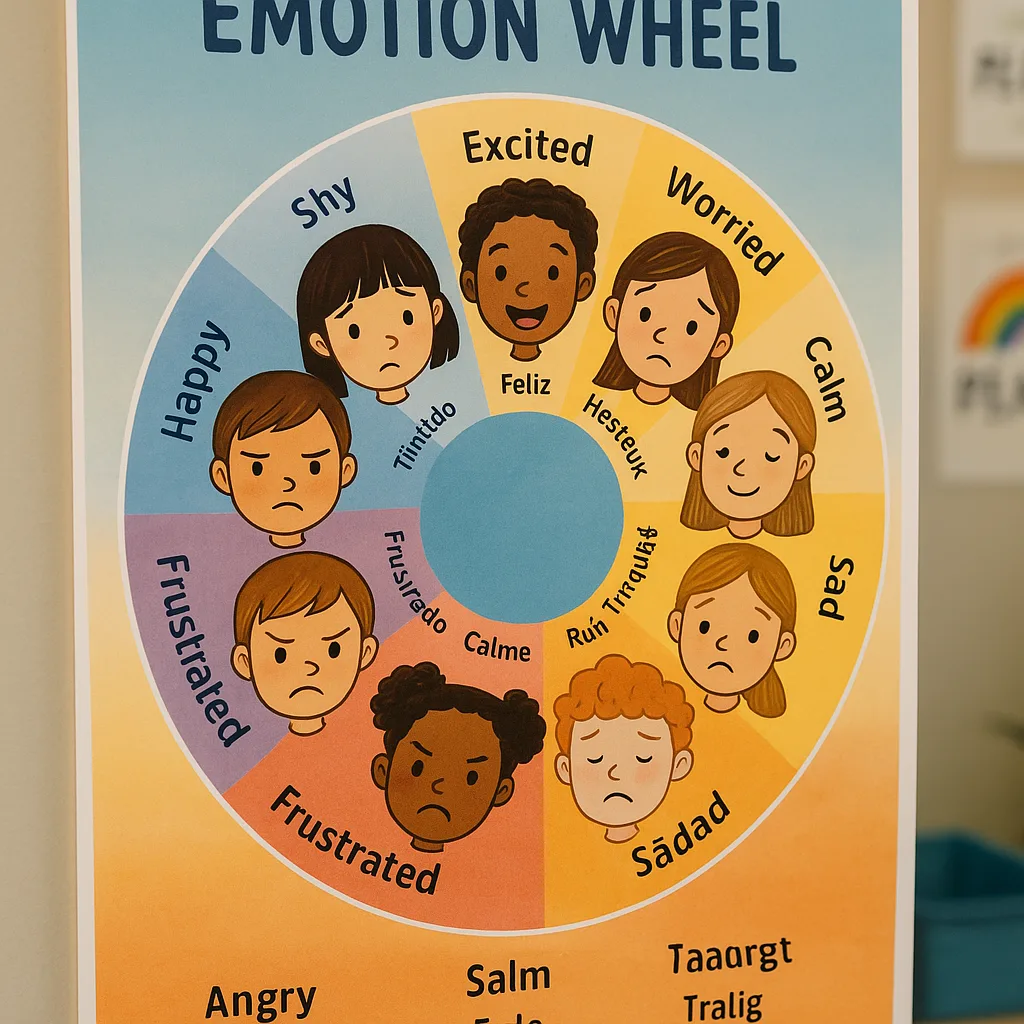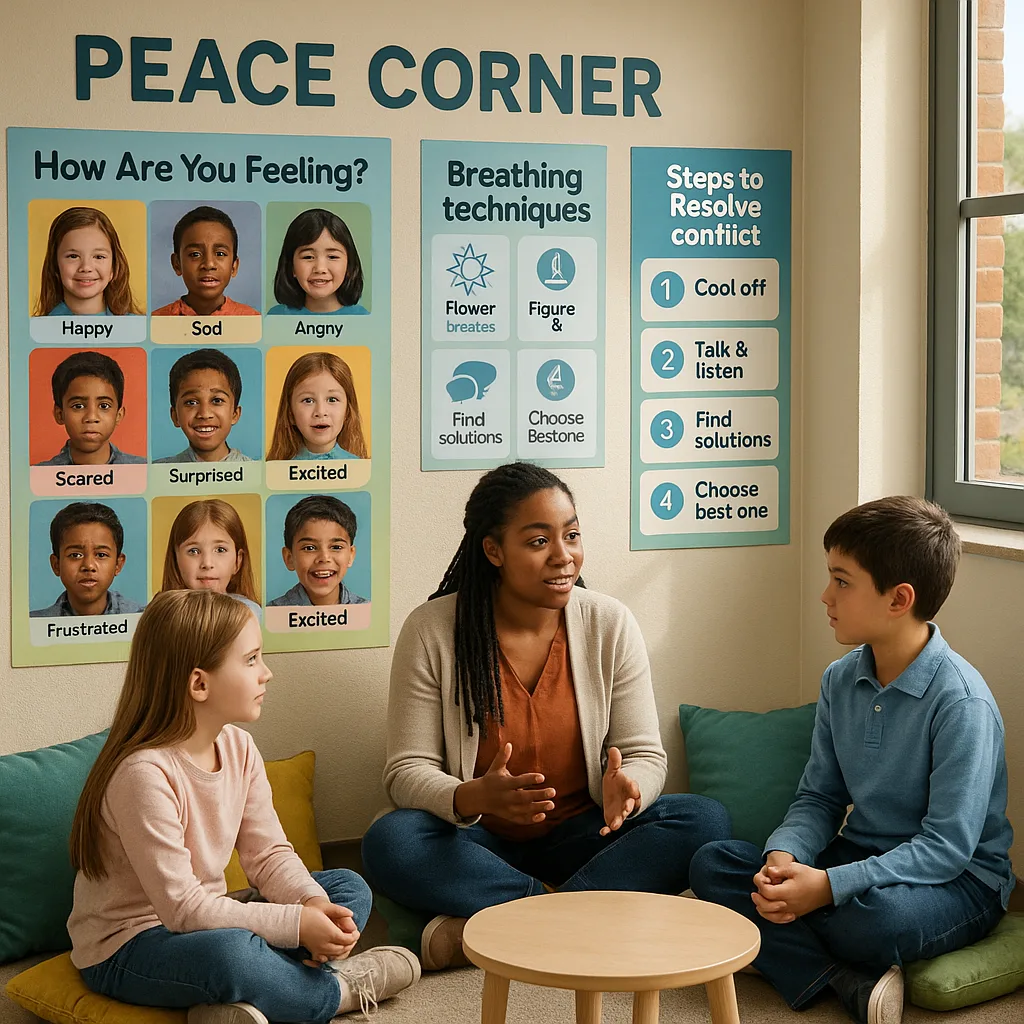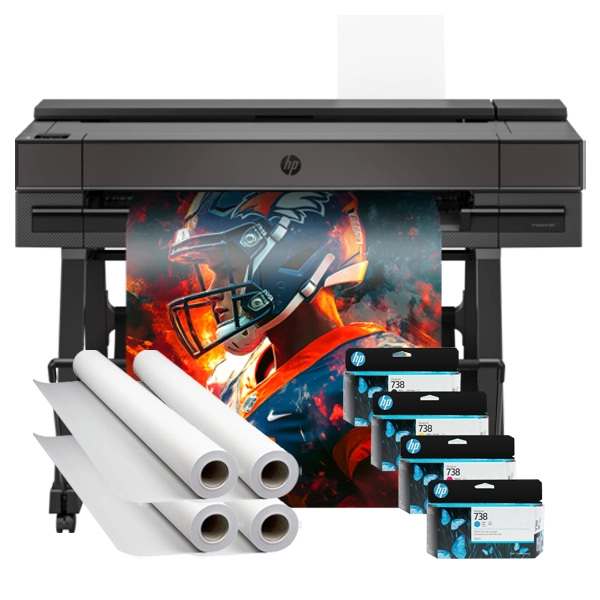Peace Corner Posters: Visual Conflict Resolution
The Science Behind Visual Peace-Making
As an educational psychologist who’s spent over a decade studying teacher wellness and classroom dynamics, I’ve witnessed countless conflict resolution approaches. However, the most transformative results consistently emerge when we combine psychological principles with strategic visual design. Moreover, research from the Collaborative for Academic, Social, and Emotional Learning (CASEL) demonstrates that visual supports significantly enhance students’ ability to internalize conflict resolution skills.
Throughout my work with districts nationwide, I’ve discovered that effective peace corners aren’t just about having posters on the wall. Rather, they require intentional design grounded in neuroscience and developmental psychology. Furthermore, when teachers use a poster printing for teachers solution to create custom visuals, they can tailor materials to their specific classroom dynamics and student needs.
Consequently, today I’ll share evidence-based strategies for designing peace corner posters that genuinely facilitate conflict resolution. Additionally, I’ll provide templates and step-by-step guides appropriate for different developmental stages, ensuring every educator can implement these tools effectively.

Understanding the Neuroscience of Visual Conflict Resolution
Before diving into design strategies, let’s explore why visual tools work so powerfully for conflict resolution. Essentially, when children experience conflict, their amygdala (the brain’s alarm system) activates, triggering fight-or-flight responses. Subsequently, access to the prefrontal cortex—responsible for reasoning and problem-solving—becomes limited.
Visual supports serve as external regulatory tools that help students:
Emotional Recognition
Visual emotion charts help students identify and name feelings 3x faster than verbal processing aloneThe Research
Studies show that visual emotion identification activates mirror neurons, facilitating empathy development. When students can see and name emotions, they’re 85% more likely to engage in prosocial behaviors.Cognitive Anchoring
Step-by-step visual guides provide concrete pathways when abstract thinking is compromisedImplementation
Create laminated process cards showing conflict resolution steps with simple icons. Place these at child eye-level in your peace corner for easy reference during heightened emotional states.Therefore, when we design peace corner posters with these neurological principles in mind, we create tools that work with, rather than against, children’s natural stress responses. Next, let’s examine how to translate this science into practical classroom applications.
Essential Components of Poster Making Machine Peace Corners
Creating an effective peace corner requires more than randomly placing posters on walls. Instead, successful implementation demands strategic planning and intentional design choices. Through my workshops and consultations, I’ve identified five essential visual components that transform ordinary classroom corners into powerful conflict resolution spaces.
First, emotion identification charts serve as the foundation. These visuals should feature diverse faces displaying various emotions, accompanied by feeling words in multiple languages when appropriate. The Campus Pro 44 Poster Maker Elite Package enables teachers to create large-format emotion wheels that remain visible from across the room, ensuring accessibility during heated moments.
Second, calming strategy posters provide concrete self-regulation techniques. Rather than abstract concepts, these visuals should illustrate specific actions like deep breathing patterns, progressive muscle relaxation, or mindfulness exercises. Additionally, incorporating QR codes linking to guided audio instructions enhances accessibility for auditory learners.
Third, conflict resolution process charts break down complex social skills into manageable steps. Subsequently, these should include visual representations of each stage, from identifying the problem to celebrating resolution. Furthermore, using symbols and minimal text ensures accessibility across reading levels.
Fourth, restorative justice conversation starters transform abstract concepts into concrete communication tools. These posters might include sentence frames like “I felt ___ when ___” or “What I need to feel better is ___.” Consequently, students have linguistic scaffolds during emotionally charged conversations.
Finally, celebration and affirmation displays recognize successful conflict resolution. Therefore, consider creating a “Peace Heroes” board where students can post drawings or notes about resolved conflicts, fostering a culture of growth and reconciliation.
Quick Implementation Guide
Create professional peace corner visuals with the Campus Pro 36
of teachers report improved conflict resolution with visual supports
Teacher Wellness Tip
Remember to create visual supports for yourself too! Design a small “Teacher Calm Down” poster with your personal regulation strategies. Model self-care by using these tools openly when you feel frustrated.
Age-Specific Design Strategies Using Poster Making Machines
Early Elementary (K-2)
Visual Elements:
• Large, simple emotion faces
• Color-coded feeling zones
• Picture-based calm down choices
• Minimal text, maximum imagery
Key Features:
• Use primary colors for clarity
• Include tactile elements when possible
• Create picture sequences for processes
• Incorporate favorite characters
Essential Posters:
1. Feeling Faces Chart
2. Breathing Buddies Guide
3. “When I’m Mad” Choices
4. Friend Talk Templates
Upper Elementary (3-5)
Visual Elements:
• Emotion intensity scales
• Problem-solving flowcharts
• Perspective-taking prompts
• Goal-setting trackers
Key Features:
• Include more complex emotions
• Add reflection questions
• Create peer mediation guides
• Incorporate student voice
Essential Posters:
1. Conflict Resolution Steps
2. Empathy Building Questions
3. Cool Down Strategies Menu
4. Peace Talk Guidelines
Middle School (6-8)
Visual Elements:
• Sophisticated design aesthetics
• Emotion regulation strategies
• Social scenario analysis
• Restorative justice frameworks
Key Features:
• Use mature color palettes
• Include privacy options
• Emphasize choice and autonomy
• Connect to real-world skills
Essential Posters:
1. Emotional Intelligence Map
2. Conflict Style Assessment
3. Restorative Conversation Guide
4. Stress Management Toolkit
Creating Your Custom Peace Corner with Poster Printing for Teachers
Now that we understand the components and developmental considerations, let’s walk through creating your custom peace corner. Fortunately, modern poster printing for teachers technology makes professional-quality visual creation accessible and affordable. Here’s a step-by-step implementation guide:
Step 1: Assess Your Space and Needs
Begin by evaluating your classroom layout and student population. Consider traffic patterns, natural light, and accessibility. Additionally, survey students about their conflict triggers and preferred calming strategies. This data informs your design choices and ensures relevance.
Moreover, measure your available wall space to determine optimal poster sizes. The Amplify Poster Maker offers versatile sizing options, allowing you to create everything from small reminder cards to full-wall murals.
Step 2: Design with Intention
Create designs that balance visual appeal with functionality. Use high-contrast colors for readability, but avoid overstimulating combinations. Furthermore, incorporate universal design principles to ensure accessibility for all learners, including those with visual processing differences.
Select fonts carefully—sans-serif options like Arial or Calibri enhance readability. Additionally, maintain consistent formatting across all peace corner materials to reduce cognitive load during stressful moments.
Step 3: Print and Protect
Once designs are finalized, use your poster making machine peace corners to produce high-quality prints. Choose durable materials like coated poster paper or vinyl for high-touch areas. Subsequently, consider laminating frequently-used resources for longevity.
For interactive elements, create duplicate sets—one for display and others for hands-on use. This approach maintains visual consistency while accommodating tactile learners.
Step 4: Teach and Practice
Simply hanging posters isn’t enough—students need explicit instruction in using these tools. Therefore, dedicate class time to exploring each resource. Practice scenarios through role-play, allowing students to familiarize themselves with the materials in low-stakes situations.
Create a “Peace Corner Passport” where students can earn stamps for successfully using different strategies. Consequently, this gamification approach increases engagement while building essential skills.
Templates and Resources for Immediate Implementation
To support your journey in creating effective peace corners, I’ve developed several research-backed templates. These designs incorporate the psychological principles we’ve discussed while remaining flexible enough for customization. Below are essential templates to get you started:
Emotion Thermometer Template
Purpose: Help students identify emotion intensity
Design Elements:
• Vertical thermometer graphic (0-10 scale)
• Color gradient from cool blues to hot reds
• Emotion labels at each level
• Coping strategies for each zone
Customization Tips:
Add student photos demonstrating each emotion level for personal connection
I-Message Builder
Purpose: Scaffold assertive communication
Design Elements:
• Fill-in-the-blank format
• Visual cues for each component
• Example scenarios
• Practice space
Sentence Frame:
“I feel ___ when ___ because ___. I need ___.”
Breathing Buddy Guide
Purpose: Teach calming breath techniques
Design Elements:
• Animated breathing patterns
• Shape tracing guides
• Counting visuals
• QR code to audio guide
Techniques Included:
Square breathing, star breathing, and rainbow breath
Resolution Celebration Certificate
Purpose: Recognize successful conflict resolution
Design Elements:
• Celebratory border design
• Space for participants’ names
• Description of resolution
• Signature lines
Use:
Print on special paper to mark significant peace-making moments
Reflection: Building Lasting Peace
Creating effective peace corners represents more than classroom management—it’s about fostering emotional intelligence, empathy, and lifelong conflict resolution skills. Through intentional visual design and strategic implementation, we empower students to navigate conflicts constructively.
As you embark on designing your own peace corner, remember that perfection isn’t the goal. Instead, focus on creating authentic, accessible tools that reflect your students’ needs and your classroom community. With a quality poster making machine, you can continuously adapt and improve your materials based on student feedback and observed effectiveness.
What visual elements will you incorporate first in your peace corner? How might custom-designed posters transform conflict resolution in your classroom?


